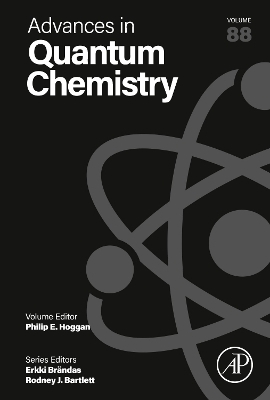
Advances in Quantum Chemistry
Academic Press Inc (Verlag)
978-0-443-18663-9 (ISBN)
Born in Aberystwyth, Wales and educated at Trinity College Cambridge, Philip Hoggan has always been French and British. After a mathematical chemistry background, he has studied a number of theoretical systems, with a DSc by research obtained in 1991 at Nancy, France on the way physical interaction between molecules and solid surfaces is a precursor to catalysis. This was treated entirely on the basis of Quantum Mechanics and applied, first to cis-trans butadiene isomerization on alumina and then a number of ‘organic’ reactions. The first lectureship was at Caen, Normandy from 1992. This period led to some fundamental research of ab initio Slater electronic structure calculations for more than 3 atoms. The first related code STOP was published in February 1996 after much work by a postdoctoral fellow A. Bouferguène, now Professor at U Alberta. After continuing to study catalytic systems at Caen, from a theoretical viewpoint, Philip Hoggan was appointed to the Chair of Theoretical Chemistry in Clermont from May 1998. This is still essentially his teaching position, although research interests have switched to solid-state (surface) physics joining the Pascal Institute for physics in Clermont from 2005. This followed a visiting professor stay of 18 months at Tallahassee, Florida in Theoretical Physics. Research emphasis has shifted from the STOP era (where the problem was solved by Coulomb Resolution in 2008) to Quantum Monte Carlo (QMC). The CNRS paid leave for a couple of years for Philip Hoggan to learn about this technique from Cyrus Umrigar, Julien Toulouse, Michel Caffarel and others. Of course, it eventually led to a project to calculate catalytic reactions on metal surfaces that was initiated by G-J Kroes (Leiden, NL) and his ERC in 2014. K Doblhoff-Dier arrived in Clermont for a ground-breaking research fellowship and each of us continues to produce very accurate work e.g. on hydrogen (production and dissociation on metals), as a clean fuel for renewable energy. Now, in 2023 we enter the 400th anniversary of Blaise Pascal’s birth. He invented calculators, some of which are in the Clermont museum. It is wonderful to work in the institute that bears his name conducting QMC on catalytic hydrogen synthesis on super-calculators: the tools that trace their roots to his ‘Pascaline’. Philip Hoggan is married and has twin daughters.
1. Spin-constrained Hartree-Fock and the generator coordinate method for the 2-site Hubbard model.Stijn De Baerdemacker, Hugh Burton, Amir Ayati, Xeno De Vriendt, Patrick Bultinck and Guillaume Acke2. Analytical evaluation of Hylleraas-CI Coulomb and Hybrid two-center Integrals over Slater orbitalsMaria Belen Ruiz3. Hartree-Fock-Roothaan Theory of Molecular Compton Profiles Via Position Space MethodTelhat Ozdogan4. Analysis of Research Trend on the Molecular Integrals Over Slater Type OrbitalsMetin Orbay, Telhat Ozdogan and Mehmet Kara5. An efficient approximation for accelerating convergence of numerical power series. Results for the 1D-Schroedinger equationAli Bagci and Zühra Günes6. The aims and objectives of algebraic molecular orbital theoryJun Yasui7. "Binding Energies for Successive Addition Reaction of .OH with C60: A Laboratory for Testing Frontier Molecular Orbital Theory"Mark Earl Casida, Abraham Ponra, Anne Justine ETINDELE and Ousmanou MOTAPON8. Potential energy curves of the LiRb+ molecular ion from ab initio calculations with all electrons correlatedMonika Musial and Grzegorz i Skrzynsk9. On the use of complex GTOs for the evaluation of radial integrals involving oscillating functionsLorenzo Ugo Ancarani10. Hartree-Fock Calculations on Atoms With Coulomb Sturmian Basis SetsDaniel Gebremedhin11. Exploring new exchange-correlation kernels in the Bethe-Salpeter equation: a study of the asymmetric Hubbard dimerPierre-Francois Loos, Pina Romaniello and Roberto Orlando12. Convergence of Møller-Plesset perturbation theory for excited reference statesHugh Burton and Diana-Gabriela Oprea13. Electronic structure in organic dye-sensitized solar cells: Insight from density functional theory and electron dynamics"Hilke Bahmann, Dejan Gemeri and Jean Christophe Tremblay14. Fully Automatic Calculations of Atomic Energy Levels With Truncation Energy ErrorsCarlos F. Bunge15. Quantum Monte Carlo method describing supported metal catalysis: Ni(111)/alumina decomposing methane as a route to hydrogen.Philip HOGGAN16. Summation By Educated Match: A Powerful Technique To Sum Both Convergent And Divergent SeriesHarris J. Silverstone17. Natural Orbital Functional Theory Studies of All-Metal Aromaticity. The Al3 anionMario Piris, Jesus M. Ugalde, Jose M. Mercero and Rafael Grande-Aztatzi18. REG-FFLUX: Lifting the veil on electrostatic interactionsPaul Popelier, Fabio Falcioni and Benjamin Symons19. Quantum Monte Carlo method for metal-film catalysis: water addition to carbon monoxide adsorbed on Pt/Al(111), efficient hydrogen productionPhilip HOGGAN, Asli Öztürk Kiraz and Ali Bagci
| Erscheinungsdatum | 23.09.2023 |
|---|---|
| Reihe/Serie | Advances in Quantum Chemistry |
| Verlagsort | San Diego |
| Sprache | englisch |
| Maße | 152 x 229 mm |
| Gewicht | 770 g |
| Themenwelt | Naturwissenschaften ► Chemie ► Physikalische Chemie |
| Naturwissenschaften ► Physik / Astronomie ► Angewandte Physik | |
| Naturwissenschaften ► Physik / Astronomie ► Atom- / Kern- / Molekularphysik | |
| ISBN-10 | 0-443-18663-4 / 0443186634 |
| ISBN-13 | 978-0-443-18663-9 / 9780443186639 |
| Zustand | Neuware |
| Haben Sie eine Frage zum Produkt? |
aus dem Bereich


